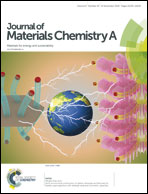Biomimetic structure design and construction of cactus-like MoS2/Bi19Cl3S27 photocatalysts for efficient hydrogen evolution†
Abstract
Cacti grown in arid areas have developed intrinsic water management systems, inspired by the cactus which has survived cruel natural selection, uncommon cactus-like MoS2/Bi19Cl3S27 heterostructures have been successfully constructed in this work. Resembling the trichome and epidermis of a cactus stem, vertically aligned MoS2 along with a carbon species hydrolyzed from glucose on Bi19Cl3S27 comprised the unique biomimetic structure. During the photocatalytic process of MoS2/Bi19Cl3S27 heterostructures, the characteristic biomimetic structure endows the heterostructures with greatly enhanced light adsorption and charge separation capabilities, the whole hydrogen evolution reaction was boosted by the combination of optimized charge and mass transfer paths, like the plant morphogenesis of a cactus which plays a significant role in mucilage-based energy-transmission. As a consequence, the improved photocatalytic H2 evolution rate reaches up to 876.6 μmol g−1 h−1 with an optimal loading of 5 wt% MoS2. The successful preparation of biomimetic structured MoS2/Bi19Cl3S27 samples with good stability shows that bismuth-based materials have great potential for applications in energy conversion systems, while providing enlightenment for the design of other biomimetic structured nanomaterials.



 Please wait while we load your content...
Please wait while we load your content...